This article covers a pioneering entrepreneur and one of the earliest industrial settlements along the Bremer River in today’s Ipswich in Queensland Australia.
This article has been extracted from, and extended on, Chapter 5 in my 2015 booklet titled “Our Karalee and Barellan Point”. I am also indebted to the assistance provided by Mr John Rossiter, some of whose ancestors lived and were born at Town Marie. Readers are encouraged to add any new information to the blog at the end of the article. In particular any sketches, drawings or photographs of Town Marie, and filling in the gaps in our knowledge of R.J. Smith, will be greatly appreciated.
The cover page of this article shows the location of Town Marie in relation to the Bremer River, Bremer Mills, Stanton Cross and the Chuwar township. Town Marie was not a gazetted name but an informal name that was in wide use in the region in the mid to late 1800s.
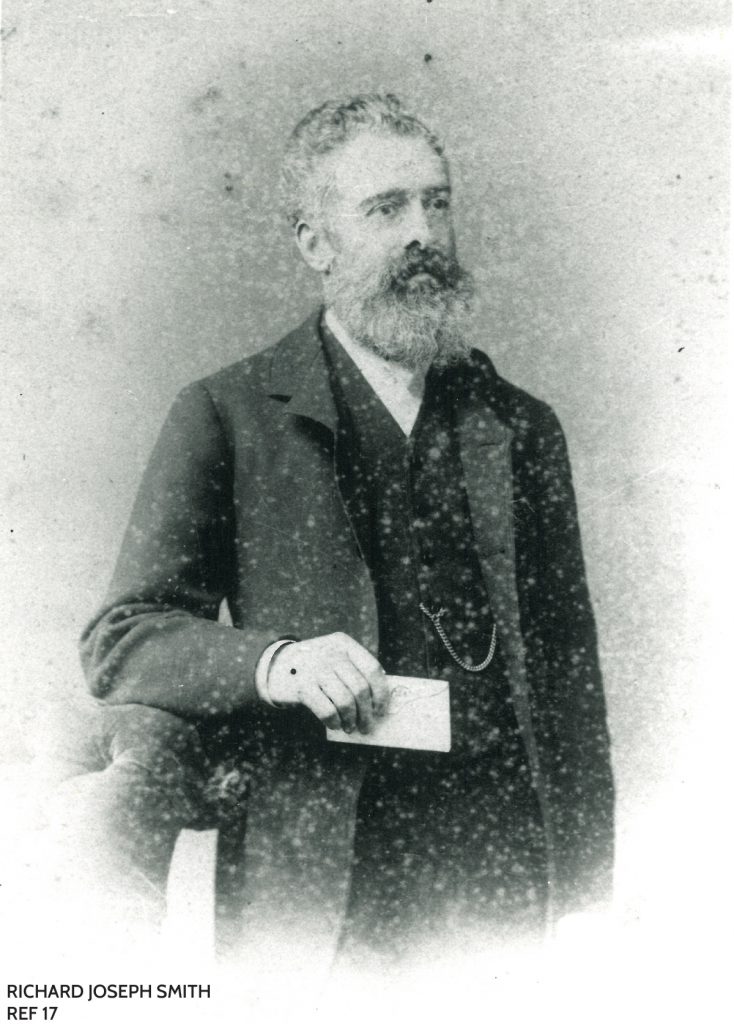
Most residents in Karalee, Barellan Point and Ipswich are unaware that land between Junction Road to the Bremer River and beyond the western end of South Queensborough Parade, was a thriving self-contained small industrial village between 1848 and 1880. Known as “Town Marie” the centre, “on the northern bank of the Bremer, almost opposite the Bremer Mills” (ref. 1) supported a ‘boiling down works’ and a sawmill with associated buildings including a house for the owner-manager and workers cottages for accommodation for employees. People were married, and children were even born at Town Marie. A tramway, to transport goods to and from a river loading wharf facility, was also in existence. Town Marie was originally accessed via the Bremer River or a dirt track that extended from Ipswich through Tivoli (ref. 2).
Town Marie was the initiative of Richard Joseph Smith who apparently named the centre after his wife’s Christian name. The Queensland Parliament records (ref 3) have provided the best information that I could initially obtain on the man and his centre. Photographs, pictures and drawings of the centre have not been found. Richard was born in Leicester England in 1819. Richard arrived in New South Wales around 1824 and moved to Brisbane in 1845. He bought original Portion 4 Chuwar, on the north side of the Bremer River, in December 1848 where by May 1849 he had established Town Marie after closing his ‘boiling down works’ in Kangaroo Point (established in 1847) “where the smell got too much for everyone” (ref. 6). The land, which extended between Junction Road and the Bremer River, is now truncated by the Warrego Highway. Town Marie also had a sister centre across the Bremer
River in Bundamba which was named “Bremer Mills” and was established by Mr Joseph (Joe) Flemming in 1851 (ref. 4). The Bremer Mills included a ‘boiling down works’, a sawmill and a flour mill. Both “Bremer Mills” and Town Marie were subsequently acquired by Mr. James Ivory in the late 1860s, with the whole entity becoming known as the “Ivory Estate”. The Ivory Estate grew sugar cane, cotton, tobacco and many other crops, including experimental types, on the land now occupied by the Citiswich Industrial Estate. Mr Ivory, who employed many South Sea Islanders to attend his crops, produced 1,275 pages of letters and nightly diary notes (held in the Mitchell Library) which the Ipswich City Council is progressively putting on the internet (ref 5). Interestingly by the 1870s the area to the west of the original Town Marie settlement on Portion 4, including the later Rossend Colliery on original Portions 1 and 2 Chuwar, was also referred to as Town Marie by Mr James Ivory. So original Portions 1 to 4 Chuwar were ultimately referred to as Town Marie.
Getting back to Richard Smith, who then became an elected member of the New South Wales Legislative Council for the pastoral districts of Moreton, Wide Bay, Burnett and Maranoa from 1 March 1853 to 29 February 1856. After Queensland separated from New South Wales in 1959 he served on the Legislative Council of Queensland between 3 July 1863 and 12 June 1866. In the meantime he married Maria Susanna Stutchbury in Brisbane on 1 December 1861. The financial crisis of 1865 resulted in Richard being declared bankrupt in 1866. Town Marie, i.e. the business and buildings and infrastructure, was then sold to Mr James Ivory around 1867 to 1868. The land however must have been leased to the new owners as the 1949 titles plan 100 years later shows that R.J. Smith (presumably the estate in the name of R.J. Smith) still owned the actual land. A 1956 registered titles plan interestingly also shows that the title of Town Marie (Portion 4) had been transferred to Claude Joseph Smith and Rebecca Sheila Smith. Are these Smiths related in some way to R.J. Smith? R.J. Smith was a member of the Church of England and apparently contributed largely to the building of St Pauls Church in Ipswich. The tablet on the wall of the church which accompanies tablets of other prominent citizens at the time, attest to his relevance to the church. He became the Chairman of the Board of Trustees at the Ipswich Grammar School. He became President of the Queensland Pastoral and Agricultural Society and between 1860 and 1863 was appointed a 1st Lieutenant of the Ipswich Mounted Volunteers. Richard subsequently became crown land agent in Ipswich and land commissioner of West Moreton before becoming the land commissioner of East and West Moreton, a position that he held until his death at the age of 64 on 15 November 1883 in Ipswich.
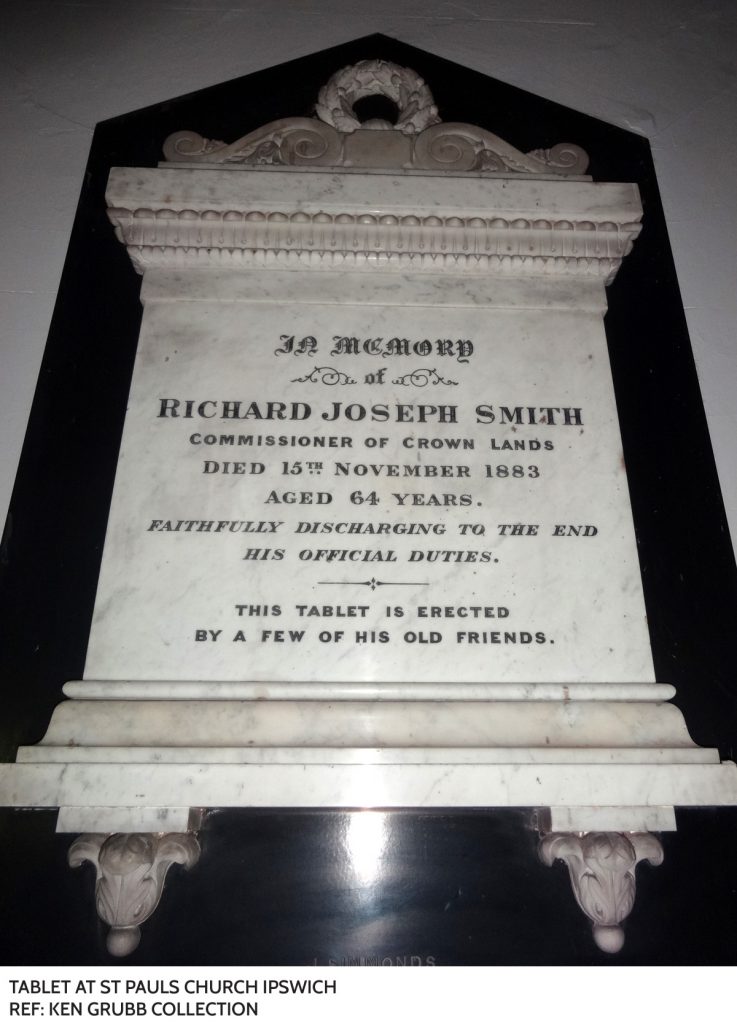
Richard also owned Portion 5 across the Bremer River in Bundamba, adjacent to Mr Joe Flemming’s ‘Bremer Mills” property. In addition he also owned Portion 33 Chuwar (which extended northwards from Junction Road to the Brisbane River and subsequently became known as Stanton Cross, being one of the earliest residential subdivisions in Queensland) as well as Portion 25 Chuwar in the loop in Brisbane River in today’s Riverside Estate where Richard’s original house away from Town Marie was located (ref. 6). Richard’s last place of residence was in part of the Lands Office building in East Street Ipswich (ref 18).
An early reference (ref. 24) by Reverend John Wallace, written in 1897, paints a picture of those times. He had been appointed as the first resident priest of the Church of England in Ipswich in 1849 and was on his first trip to Ipswich to take up that position. Roads were mere winding dray tracks through the bush. With the help of an ex-convict he and his horse Rover found their way to a point on the Bremer River opposite to the newly established boiling down works of R.J. Smith. It was dark, but he was able to attract the attention of an employee to assist him in crossing the river. After securing Rover he scrambled down the steep bank and found the man who had crossed the river in a ‘dugout’ boat. The reference states that:
“ ‘Take care how you get in’ he said. The boat was barely two feet broad, but very long. It was pitch dark, but I got in dry and he paddled us across to the opposite bank which was just as steep. He told me Mr Smith’s house was a little way up, and I scrambled up and walked along a track till I came on the buildings, but had some difficulty in finding a door. I knocked. Presently, the door was opened by one of the handsomest women I ever saw. It seems that they expected me but had given me up for the night. I soon was sitting down to supper, which consisted, I remember, of tea without milk and brown sugar, damper (unleavened bush bread) and a tin of sardines – the first I had ever tasted.
Mr “Boiling Down Smith”, as the squatters whose sheep and cattle he boiled down called him, came in presently. His wife was a tall, dark, handsome brunette. He was a fair, stout, jolly-faced, jovial man. He had only been there one season and had boiled down 10,000 head of cattle and 42,000 head of sheep.
The population of the district was small and scattered. The sheep, cattle and horses were numerous and were valueless except for their hides, skins and fat. You could buy a fat bullock for 20/- or 30/- and after a sheep reached 7 or 8 years, its fleece deteriorated and they could not be sold as mutton, so had to be boiled down for their fat and pelt.
There was only one sitting room, one bedroom and a large storeroom piled with bags of flour, sugar, slop clothing, boots and saddles, and here on some bags of flour my bed was made and a couple of blankets given me. I was soon undressed and asleep. So it was that I made the acquaintance of my first parishioners in my first parish of Ipswich in Queensland………………………………………………………..
He (Mr Rusden) came and lectured at Brisbane and then to Ipswich, and he was taken up by Mr Smith of Town Marie, a rather appropriate advocate of anti-religious teaching, since it subsequently appeared that Mrs Smith was not his wife, he having run away with her in England, leaving her husband and children. Mr Smith asked me to attend the meeting and said they were going to build a school and establish a secular system, but I declined, knowing that opposition would only give them the backbone they needed, and that I would let them have their say and then I would have mine.”
The following is an extract from “Adventures in Australia 1852 – 1853” by the Reverend H. Berkeley Jones M.A.
“At last we arrived at the ‘boiling down establishment’, not however, without some difficulty as to which Smith it was we were to visit, as they both had boiling down establishments. “Do you mean Schemer or R.J. Smith?” asked the commander. “We mean R.J. Smith”, which was sufficiently descriptive of the person we required and who was to put us in the way of getting up the country……We found ourselves agreeably housed in a pretty dwelling, surrounded by grounds laid out with great taste. Before we retired for the night, our fair and amiable hostess cautioned us not to be alarmed at the mice running about between the paper and the wall, and, certes, we did not repose much, for incessant races they ran; it must have been a great field day, alias night, with them. Some great political changes must have been on the tapis in their commonwealth, if we could judge correctly from their activity. At any rate, what with the noise which they made and the buzzing of mosquitoes, we had not much balmy sleep; in the early of the morning, the breeze having set towards the house, we were aware of an odour acting on our olfactory nerves……these masses of putrescent matter, which lie distant from this pretty place about five hundred yards, filling a ditch of twelve feet deep, with swine feeding upon a heap of coagulated filth, the refuse of the boiling down house. We could not remain about a few hours with the kind and hospitable owners, and therefore, before lunch we bade adieu….”
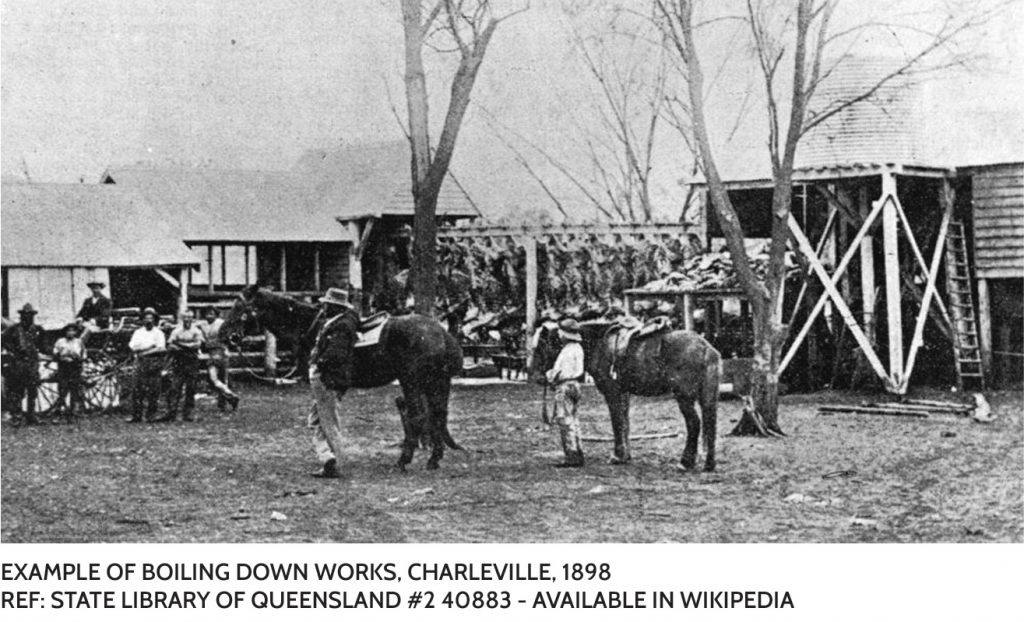
Boiling down works and sawmills were some of the earliest secondary industries in Queensland. Town Marie was processing up to 100 cattle and 2,000 sheep per day (ref. 3). After removing hides and meat, the remaining parts of the carcasses were boiled to produce fat or tallow, mainly to produce candles and also for fuel for fat lamps. ‘Redgum’ in reporting in the Queensland Times (ref 7) stated that a large boiling down works existed at Town Marie near Tivoli. Redgum stated that “I remember visiting RJ’s establishment when a lad, and there was a great number of men employed there. ‘Gipsy Bob’, John Clements, a couple of Slacks, a McGrory and many other old hands. Cask making was a flourishing trade and the coopers were very busily occupied. Silky-oak wood was formed into staves and these casks of tallow were sent across the water to England. Tallow candles were the lights used in my boyhood days.” The boiling down works were smelly and dirty places where all the left-over bones were initially simply thrown into the river. One of the repercussions of these early activities came to the fore in 1852 for example when a paddleboat, on a trip from Brisbane to Ipswich, ran aground at Town Marie on the bones in the river (ref. 8). An early and later bone crushing plant was however constructed to alleviate the problem of bone disposal (ref. 19).
The wood for the sawmill was transported by bullock teams and by river. Silky Oak has been mentioned for the making of the tallow barrels. Other types, including pine from the nearby Pine Mountain, was also brought in for sawing.
By 1866 we read that (ref. 25) a Mr Davis was leasing the meatworks at Town Marie for the purpose of curing meat by a new method. The article states that:
“We stated some time ago that a gentleman named Davis, of Adelaide, who had purchased Professor Morgan’s patent for curing meat by injection was on a visit to Ipswich in search of a spot in which to commence operations. It was first thought that the Bremer Mill would be suitable for the purpose, but circumstances subsequently led to the selection of the Town Marie boiling establishment of Mr Smith, which has been taken by Mr Davis for the purpose of starting his new industry, and a portion of the material has already been placed on the ground…. We may state that it is only the boiling down establishment at Town Marie which has been taken by Mr. Davis; the sawmill and residence still remain in the occupation of Mr Smith.”
The Queensland Times of 8 September 1866 (ref. 21) carried the news that Town Marie was to be sold at public auction by the mortgagee, at the City Auction Mart in Brisbane, on Monday 17 September. The advert stated that:
“The valuable property, known as Town Marie Queensland, consisting of freehold estate of 83 acres of land, with frontage to the Bremer River, and also the main road from the Junction to Ipswich, which is distant about 5 miles. On this property are erected and in full working order, a large and complete steaming and boiling establishment, for working closed digesters or open pans, capable of disposing of 100 head of cattle or 2000 sheep per day, either by boiling or steaming, with tallow sheds, hide houses, rendering room, cooperage, stock and drafting yards, slaughtering houses etc etc. A portion of the boiling establishment is now let at a rental of 200 pounds per annum for the purpose of curing meat on Dr Morgan’s principle. The sawmills are in good and substantial working order, all the machinery etc being first class and as good as new. There is a self-acting rack bench, iron top, capable of taking a log 6 feet in diameter and a small bench for small timber. These are driven by a horizontal engine of 16 horsepower, all the machinery leaving been set by first class workmen i.e. solid masonry and substantial and heavy hardwood timber. There is also a vertical saw frame, set on a new and improved principle, for breaking down heavy timber or sawing broad planking, driven by a 16 horse power engine in thorough working order and also a steam winch for drawing the timber from the river to the mill. The timber arrives at the establishment by the river and there are railways laid down to convey it to and from the mill. There is an extra pulley in the main shafting which works a bone mill attached to the establishment.
The mills consist of three large and substantial buildings, joined together, constructed of hardwood and roofed with galvanised iron. There are railways all through the mills, together with turntables to economise labour. The mill is divided off into circular sawmill, vertical sawmill, steam boiling house, engine room, saw room, counting house.
A wharf for the shipping and receiving of timber fitted with a double action crane to carry five tons. On the establishment there are a sufficient number of houses, cottages, huts etc for the firemen, workmen, and mechanics engaged upon the different works.
The house at Town Marie consists of a most comfortable homestead of nine rooms, containing drawing room, dining room, bedrooms, dressing rooms, pantry, office etc together with detached barracks for gentlemen; also store, kitchen, dairy, servants bedroom, courtyard, stables, coach house, fowl house, pigeon house, pigsties, milking yard and bails, calf pens, horse yard, paddocks, flower, fruit and vegetable gardens – all being fully laid out.
For sawing purposes the property is situated in the very heart of the timber, both pine and hardwood. To a capitalist the property would return a very handsome income, which would be increased as the railway becomes completed to the Downs. For particulars of terms etc, intending purchasers are solicited to communicate with the Auctioneer, Queen Street Brisbane.”
The meat processing component at Town Marie had a rebirth in 1870 judging by the information in an article in the Sydney Mail of 17 September 1870 (ref 19). The reporter visited the site shortly after it recommenced working in 1870. The operation was known as ‘Town Marie Meat Preserving Establishment’ and the proprietors were Messrs Manning and Staiger. The reporter describes in some detail how the various processes worked as well as the products produced. The large range of products included wool, hoofs, horns, skins, tripes, hams, sausages, salted tongues, concentrated horse food, concentrated gall for cleaning stains from gentlemen’s clothing, neat’s-foot and trotter oil, dried blood fertilizer and blood bone and offal manure. The proprietors also planned to start making glue. At this time the operation was processing 1,000 sheep per week. Sydney was the main market for the wool and tallow. The meat mainly went to England. The rest of the products were sold locally or as far away as the ‘colonies’. All the boxes and casks were manufactured on site from Silky Oak and the tins were made in Ipswich and Brisbane. The reporter finally states that all of the exports were shipped by river steamers from a wharf especially erected for use by the firm.
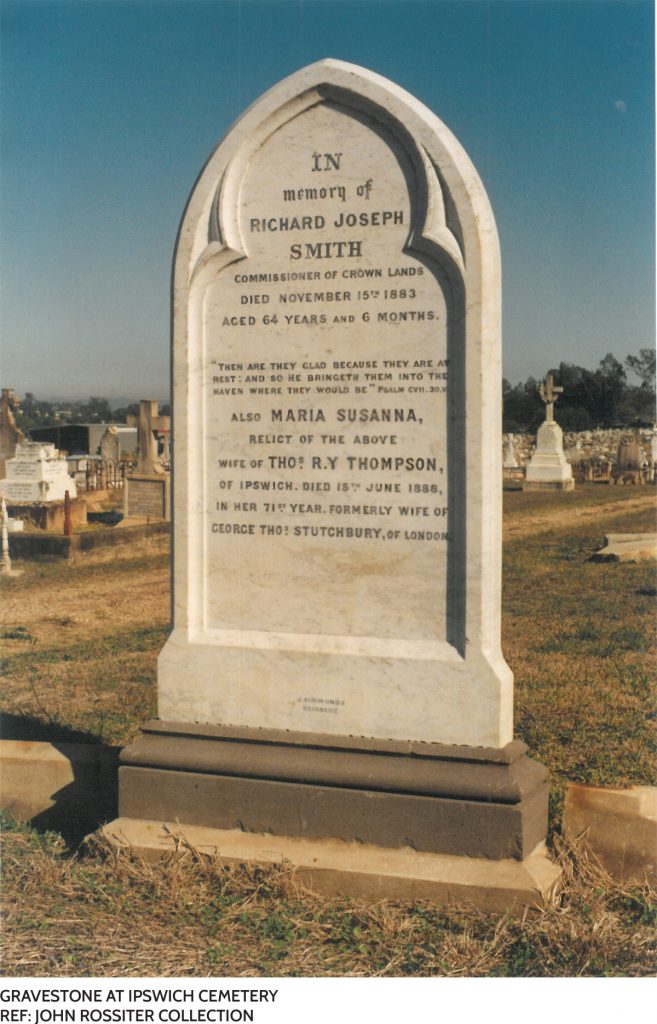
The death notice of R.J. Smith on Saturday 17 November 1883 (ref 26) stated that:
“News was received in Brisbane on Thursday of the death of Mr R.J. Smith, Inspecting Commissioner of Crown Lands, and Commissioner for The Brisbane District. The sad event was not altogether unexpected, as it was known that he suffered greatly during the last few weeks from dysentery; but among the many friends he has made during his long residence in Queensland the intimation of the death of Mr Smith will be received with deep regret.
A contributor at Ipswich, who has known the deceased gentleman since his first arrival in the colony, supplied us with the following interesting account of his life:
There are in every one of the Australian colonies, and in this part of Queensland in particular, hundreds, aye, thousands, who have learned to love him who was more than a good, honest, painstaking, obliging officer, who was in reality a kind friend to all who had business with him; who, ever patient, ever courteous, ever anxious to serve his fellow men, never tired of helping the men – nearly all poor – with whom he was ever in contact. The writer well remembers him when he first came to the colony in 1845, and he was then, as a young man, the same mild, quiet, obliging, gentle, inoffensive man that he was the day he lay down to take his last rest. During those thirty-eight years – through all of which the writer knew him well – he was the same: a kind, good friend, charitable, ever seeking to lead the way in every public or private good, ever ready with voice and purse to help those who were unable to help themselves.
Mr Smith and his wife arrived in what is now Queensland in 1845, and, after residing a short time at Kangaroo Point, Mr Smith purchased a large quantity of land on the Bremer, about seven miles from Ipswich, which he named Town Marie, after his wife. Here he carried on very extensive boiling-down operations, dealt extensively in timber, and was concerned in several cattle stations. He was elected a member of Parliament (then sitting in Sydney) in 1852, and held the seat for several years. After separation he was offered by Sir George F. Bowen and accepted a seat in the Legislative Council of Queensland, which he also occupied for several years. Then came a time that, alas, too many have cause to remember. The financial crisis of 1865 laid even the strongest low, and Mr Smith, foreseeing the impending crash, wisely withdrew from business pursuits. Directly after this a more liberal administration of the land laws was demanded. The Government eagerly sought and secured Mr Smith’s services, first as land agent and then as Commissioner for Lands, to carry out the provisions of their new land policy; and the wisdom of the choice has ever since been abundantly proved by the successful manner in which he administered the provisions of the several Acts of Parliament passed since his appointment; indeed, it may be said that it has been mainly through his exertions and his intimate knowledge of almost every corner of the district, untiring patience, honesty of purpose, and eager desire to serve others that the very large farming population now in West Moreton were settled down.
Mr Smith was a member of the Church of England, contributed very largely to the building of St Paul’s Church in Ipswich, of which he was ever a very liberal supporter, as indeed, he was of every good work. He also took a deep interest in the Grammar School, and some years ago succeeded the late Dr. Rowlands as chairman of the board of trustees, a post he has held ever since. His private charities were not small, for his hand and heart were ever opened.
He leaves a wife, but no children; but many, many there are who will sorrow for their friend, and, in the language of the poet, will say, ‘Oh! For the touch of the vanished hand, For the sound of the voice that is still.’ “
An undated reference by Ray Rogan (ref 6) stated that “It is ironic that Richard went bankrupt while one of his indentured workers, a man who confessed to murder on his deathbed, Patrick Mayne, laid the foundations of a multimillion dollar family business in Brisbane. Mayne’s son was a great benefactor of the University of Queensland.” Patrick Mayne probably worked at Richard Smith’s original Kangaroo Point boiling down works and possibly at his later Town Marie works.
As mentioned earlier the land to the west of original Portion 4, including Portions 1, 2 and 3, was also referred to as Town Marie in the 1870s and 1880s. The following extract (ref 22) is a reporter’s description of the Rossend Colliery on original Portion 1 in 1877 :
“Lindsay’s mine…is situated in a little pocket in the bend of the river. The pit’s mouth is a quiet-looking place, surrounded by thick forest and a stranger approaching it from the road would scarcely imagine that any such work as coal mining was going on there. The drive is roofed over at the entrance, as is done in every case, and a rail and plank tramway extends the whole length of the drive; but the trucks are pulled out of the mine, two at a time, by a horse attached to a rope walking straight away from the pit’s mouth down a slight incline. On reaching the surface the trucks are run out on a platform, turned round, and run out onto the train leading down to the shoots; this is similar to the tramway in the drive, as the small trucks are used on both. The horse draws twelve of them at a time (which is equal to three tons of coal), the road being free from anything like heavy gradients and only 600 yards in length. The coal is tipped straight into the shoots, which hold about 120 tons…Off the main drive there are eight rooms all working, employing eight men and a boy, and turning out about 15 tons of coal per day…Mr Lindsay has sunk a shaft…140 feet in depth…to use as an outlet for the coal which will then be hoisted out by means of a horse-gin…The workings underground are within about 50 yards of the bottom of the shaft.”
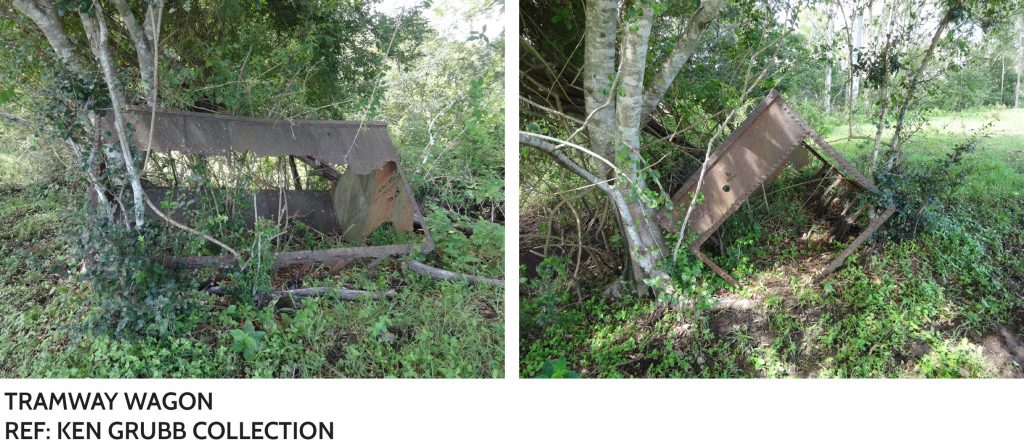
The following are snippets that I have managed to obtain in connection with Town Marie:
- 1850’s ‘Bonebreaker’ and two other Aboriginals were taken to Town Marie when the drays were returning there from Kenilworth (ref 18)
- 1853 – 1856 Edward Griffiths worked for R.J. Smith at Town Marie boiling down works (ref 15)
- 1855 25th April Caroline Bannister born at Town Marie (ref. 9)
- 1855 Edmond Aylward lived at Town Marie (ref 10)
- 1856 Patrick Aylward lived at Town Marie (ref 10)
- 1857 Elizabeth Jackson born at Town Marie (ref 18)
- 1850s or 1860s “Charles Yarrow first worked as a labourer then obtained a job at Town Marie at the boiling down works run by R.J. Smith” (ref. 11)
- 1860s Richard Symes Alford stated that “I took two draughts of fat cows from Coochin (Coochin Coochin Station at Mt Alford) to Town Marie meat works which were in charge of Carl Staiger and situated on the Bremer River a short distance below Ipswich” (ref 12).
- 1861 John and Mary Ann (nee Packer) Rossiter lived at Town Marie (ref. 15)
- 1861 William Barram or Barkham married his second wife Maria Woodcock on 20 February at Town Marie. He was a carpenter, farmer and shop keeper (ref 15)
- 1861 Mary Ann Rossiter junior born at Town Marie on 25 August
- 1862 Florence Maria Smith, infant daughter of R.J. Smith lessor of Town Marie, died aged 10 months on 4 February (ref. 16)
- 1863 R.J. Smith was in the official party when Ipswich Boys Grammar School was inaugurated by Governor Bowen (ref 27)
- 1866 Mr F. R. Davis selects the boiling down works at Town Marie as the location for meat curing by injection, using the Morgan patent method, on 4 January (ref 20)
- 1866 John Rossiter junior born at Town Marie on 7 February
- 1866 Robert Patterson Bannister, known as ‘Gypsy Bob’, worked as a butcher for Mr. B. Davis at Town Marie. He married Eliza McCreedy in 1849. He is listed as a ‘timber getter’ on his death certificate (ref 15).
- 1866 Mr George Livermore was employed as a cooper initially at the Aberdeen Boiling Down Works on the Bremer River opposite Moores Pocket in 1855, then in 1856 coopering at the Bremer Mills, then later at Town Marie until 1866 before setting up his own business (ref 28)
- 1870 Messrs Manning and Staiger were proprietors of the ‘Town Marie Meat Preserving Establishment’ (ref. 19)
- 1872 22nd April. James Ivory stated that “went with Willie in boat to Town Marie to see Mr Haye about 2 samples of minerals I got from a prospector, very likely tin! sample” (ref. 5)
- 1873 1st November. James Ivory stated that “took Willie over to the other side (of the Bremer River to Town Marie) to look for the coal shaft and saw where one supposed it to be” (ref 5)
- 1874 15th October. Albert Pioch born at Town Marie (ref. 13)
- 1875 ‘Redgum’ stated that “In February 1875 James Lindsay had removed to Town Marie, and the mine he opened there, on the Ivory Estate, was worked by Mr. James Lindsay for the purpose of mining and selling coal, the another having been Mr Henry Farley of Stanthorpe. The mine in those days was known as Rossend” (ref. 14).
- 1876 30th July. Barnhardt Pioch born at Town Marie (ref. 13)
- 1878 30th May. Martha Louis Pioch born at Town Marie (ref. 13)
- 1880 8th January. Helene Auguste Pioch born at Town Marie (ref. 13)
The parents of the Pioch children were Carl (born 1847 in Prussia) and Louisa Caroline nee Schroeder (ref. 13). The family settled in Ipswich around 1873 after which Carl began farming, then became a coal miner for a short period before joining the railways. The birth of these children at Town Marie is almost certainly to have been when Carl was working as a coal miner there.
So some of the people that visited, worked, lived or were born at Town Marie have included Aylward (Edmond and Patrick), Bannister (Robert = “Gypsy Bob” and Eliza and daughter Caroline), William and Maria Barram or Barkham, Berkley Jones (Reverend H.) Clements (John), Davis (F.R.), Farley (Henry), Griffiths (Edward), Haye, Lindsay (James), Livermore (George), Manning (James), McGrory, Pioch (parents Carl and Louisa and children Albert, Barnhardt, Martha and Helene), Rossiter (John and Mary Ann and children Mary Ann junior and John junior), Slacks (a number of), Smith (Richard Joseph and Marie and infant daughter Florence Maria), Staiger (Carl), Wallace (Reverend John) and Yarrow (Charles) as well as possibly Patrick Mayne.
Pam Jennings, who established that her relative worked at Town Marie, obtained the following list of Town Marie workers from the Moreton Bay Courier of 7 May 1853:

The Town Marie lands in later years became the location of the Stafford brothers’ Haighmoor Colliery (1894 – 1909) after the closing of the Rossend Colliery and still later the location of the New Ebbw Vale and subsequent Haighmoor Extended Collieries (1944 – 1974). The Abermain power station (1953 – 1967) was also constructed next to the tunnel entries to the Haighmoor Extended Colliery.
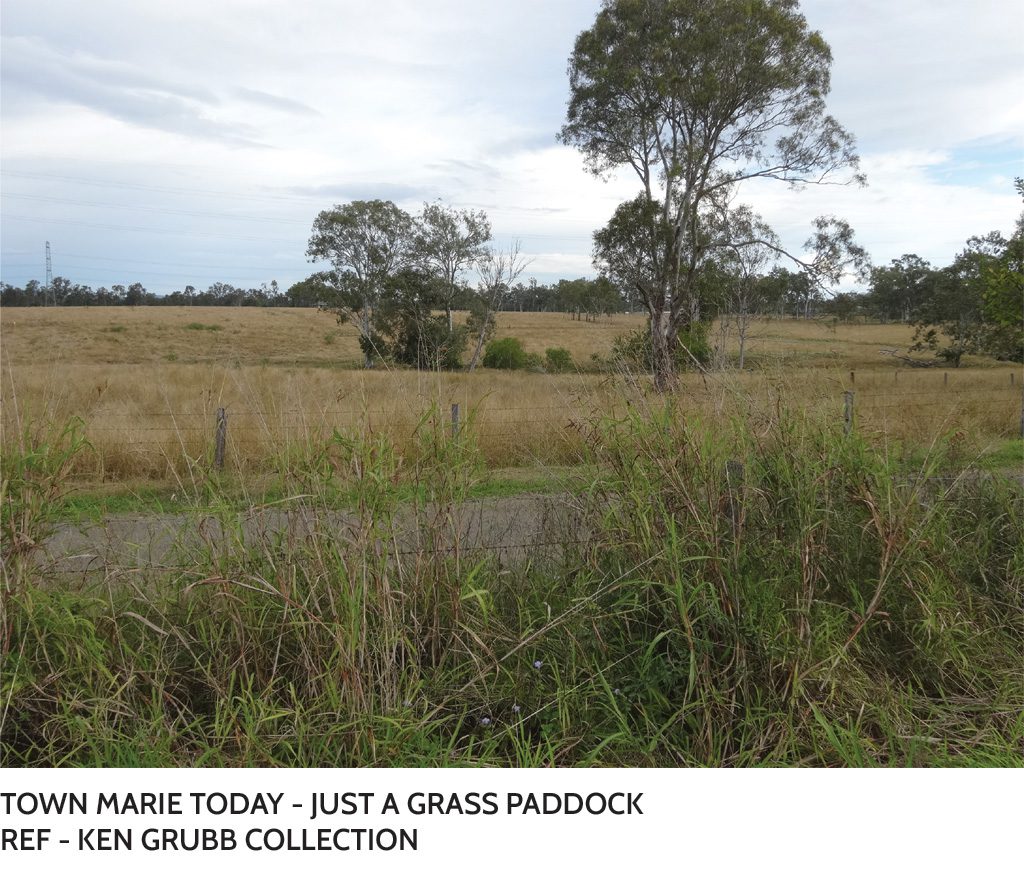
Very little now remains of Town Marie on original Portion 4. The original area of the meatworks and sawmill, now on private property on the south side of the Warrego Highway, is now grassland with only some bricks and rusted tram wagons remains along the banks of the Bremer River. The residential estate around Phar Lap Parade and Archer Court in Karalee, on the south side of the Warrego Highway, now occupy the area of the original homestead and workers houses at Town Marie. To the west the old coke ovens and old power station building are now also located on private property occupied by a transport company.
Further researching can be done using information prepared by the Queensland Family History Society. No less than 245 reference points for Richard Joseph Smith are included in their Pre-Separation Population Index. The Application Package No. 2727 held at the Department of Natural Resources and Mines also gives further information on title and insolvency matters associated with Richard Joseph Smith’s bankruptcy in 1866.
Finally, there is little doubt that this amazing ghost town needs to be acknowledged, with a historic place monument at one or more locations.

References
- ref. 1 ‘Redgum’ in QT 28 February 1923 in Trove
- ref. 2 Beryl Johnston in QT 8 November 2014
- ref. 3 www.parliament.qld.ov.au/formermembers
- ref. 4 ‘Redgum’ in QT 28 February 1928 in Trove
- ref. 5 James Ivory’s diary notes transcribed by the Ipswich City Council
- ref. 6 Ray Rogan in “The Ipswich Bulletin, Area A” December-January 2007
- ref. 7 ‘Redgum’ in QT 21 July 1920 in Trove
- ref. 8 www.mountainstomangroves.org.karana_mt_crosby
- ref. 9 Bannister Family on Ancestry.com
- ref. 10 Founding Families of Ipswich Pre-1900 at Ipswich City Council
- ref. 11 A Place in History by Robyn Buchanan in QT
- ref. 12 Richard Symes Alford (Memories of Years Gone By) in www.queenslandhistory.com/alford
- ref. 13 Pioch Schroeder connections in Tribal pages in Ancestry Genealogy
- ref. 14 ‘Redgum’ in QT 8 July 1911 in Trove
- ref. 15 Founding Families of Ipswich pre-1900 – Ipswich City Council www. ipswich.qld.gov.au
- ref. 16 the Brisbane Courier 14 February 1862 in Trove
- ref. 17 Rosewood Scrub Historical Society in Moreton Shire Queensland – “Discovery and Settlement” bicentennial publication 1988
- ref. 18 “My Search for Town Marie” by Val Wilson in Queensland Family Historian, pg 136 – 138 Volume 23 No. 4 November 2002
- ref. 19 “A Queensland Local Industry” in the Sydney Mail Saturday September 1870
- ref. 20 Queensland Times, Ipswich Herald and General Advertiser, 4 January 1866 in Trove
- ref. 21 Queensland Times, 4 September 1866 in Trove
- ref. 22 Queenslander 24 February 1877 in “Coal in Queensland, the Late Nineteenth Century” 1985
- ref. 23 “Our Karalee and Barellan Point”, July 2015 by Ken Grubb
- ref. 24 ‘John Wallace Memoirs’ and autobiography of Rev. John Wallace, written in 1897
- ref. 25 Queensland Times 4 January 1866 in Trove
- ref. 26 The Queenslander 17 November 1883 in Trove
- ref. 27 Redgum in The Queensland Times 3 March 1894
- ref. 28 personal communications with Mr Lloyd Eagle
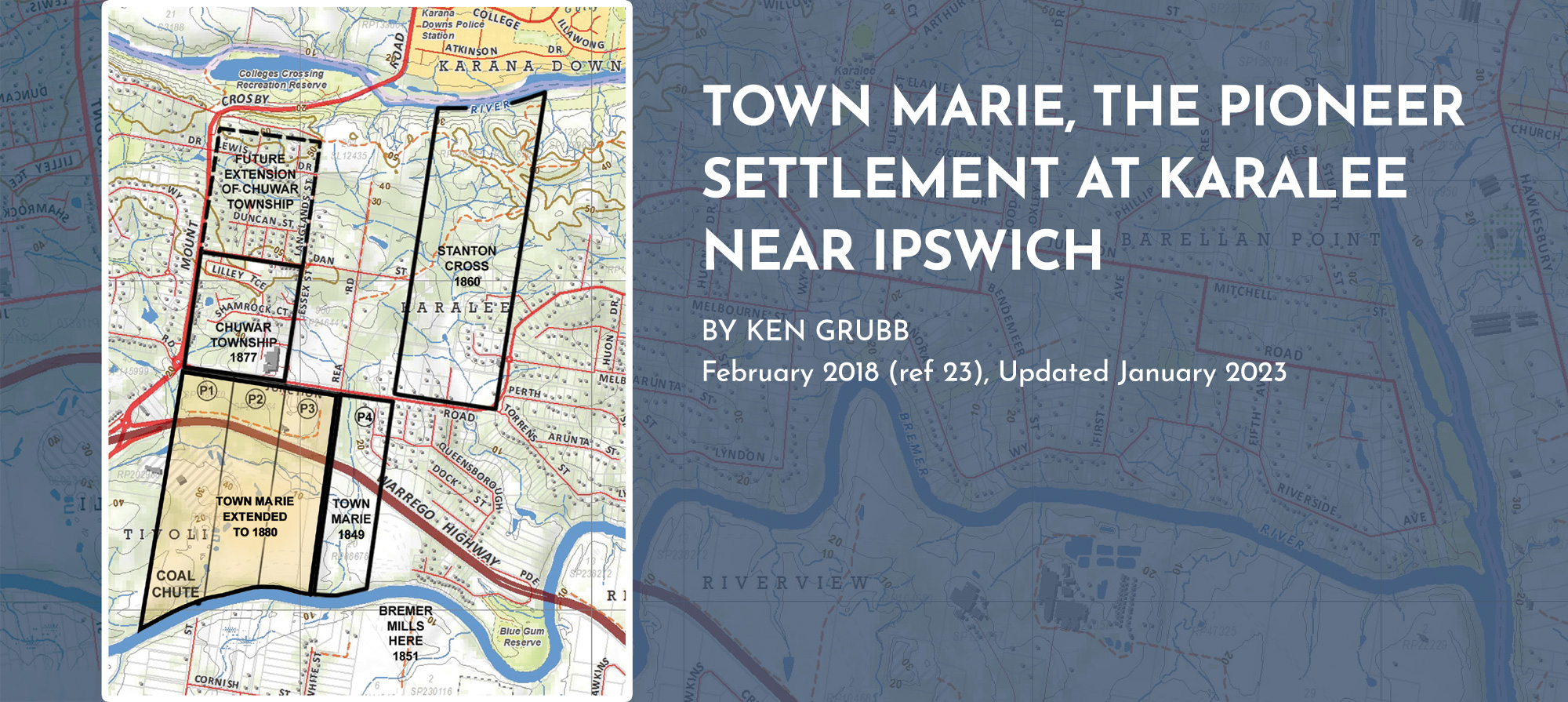
Hi Ken,
Thanks for posting this fantastic resource. I found an article about my grandfather’s grandfather, Charles Yarrow, placing him at ‘Chewar’ in 1862. “Local and District News.” Queensland Times, Ipswich Herald and General Advertiser (Qld. : 1861 – 1908) 25 April 1862: 3. Web. 31 Mar 2024 . This may narrow down the time-span listed on your website (1850’s-60’s) of Charles’ residence at Town Marie.
Hi Ken – I have just discovered than an ancestor, Samuel Crabb, was overseer for R J Smith for 16 years when he died in 1863.
DEATH. At Town Marie, on the 29th instant, after few days illness, Mr. Samuel Crabb, aged 44 years, Overseer to R. J. Smith, Esq., in whose service he had been 16 years. He was a good and faithful servant, and much respected by all who knew him. The Queensland Times. IPSWICH, TUESDAY, JUNE 2, 1863.
This may be of use to your interest in this place.
Thank you for all the information here. I have done research on Charles Yarrow as he married my paternal 2x great-grandfather’s cousin Jane Titmarsh and they all came together on the “Argyle” voyage in 1852. I also have ancestors on my maternal side the Reedy family who came on the same voyage and am still to learn whether they were involved with RJ Smith’s businesses. They lived at what was originally known as Long Pocket before selecting land beside Bundamba Lagoon next to land that James Ivory had there. One of their daughters supposedly married a Bernard McKeown and some of the children’s certificates say they married in the south seas or Tonga. Others say they married in Sydney. I have my doubts there was a wedding anywhere but do believe Bernard was linked to the South Sea islanders who worked for James Ivory on his Bundamba lagoon property.
Readers are encouraged to add any new information to the blog at the end of the article. In particular any sketches, drawings or photographs of Town Marie, and filling in the gaps in our knowledge of R.J. Smith, will be greatly appreciated.